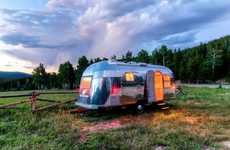
The House on Geul River by Upfrnt Features a Flood-Proof Design
Jana Pijak — September 12, 2013 — Art & Design
The House on Geul River by Upfrnt is designed with a flood-proof concept in mind. This whimsical abode is located on the bank of the Geul River in South Limburg, the Netherlands and stands atop a raised stilt frame.
With both hand-built and pre-fabricated elements, this stunning tree-house abode was built to replace damaged homes that graced the site previously.
Because of the river's frequent flooding, this structure is built on poles that are made from local wood materials.
Rising above flood waters, the House on Geul River features a sustainable design concept that includes solar heating and waste-water filtration and purification systems. The home features large windows that allow natural light in while its gorgeous cedar facade boasts the traditional Japanese Shou-Sugi-Ban technique.
With both hand-built and pre-fabricated elements, this stunning tree-house abode was built to replace damaged homes that graced the site previously.
Because of the river's frequent flooding, this structure is built on poles that are made from local wood materials.
Rising above flood waters, the House on Geul River features a sustainable design concept that includes solar heating and waste-water filtration and purification systems. The home features large windows that allow natural light in while its gorgeous cedar facade boasts the traditional Japanese Shou-Sugi-Ban technique.
Trend Themes
1. Flood-proof Housing - Creating flood-resistant housing structures using raised stilt frames and local wood materials presents an opportunity for disruptive innovation in the construction industry.
2. Sustainable Design - Incorporating solar heating, waste-water filtration, and purification systems into housing designs offers a disruptive innovation opportunity in the sustainable architecture and renewable energy sectors.
3. Traditional Craftsmanship Meets Modern Design - Infusing traditional techniques like the Japanese Shou-Sugi-Ban with modern housing designs opens up possibilities for disruptive innovation in the construction and interior design industries.
Industry Implications
1. Construction - The construction industry has the potential to make significant advancements in flood-proof housing through the development of raised stilt frame structures and the use of local wood materials.
2. Sustainable Architecture - The sustainable architecture industry can innovate by incorporating solar heating and waste-water filtration and purification systems into housing designs to promote environmentally friendly living.
3. Interior Design - The interior design industry can explore disruptive opportunities by infusing traditional craftsmanship techniques, such as the Japanese Shou-Sugi-Ban technique, with modern housing designs.
6.3
Score
Popularity
Activity
Freshness























